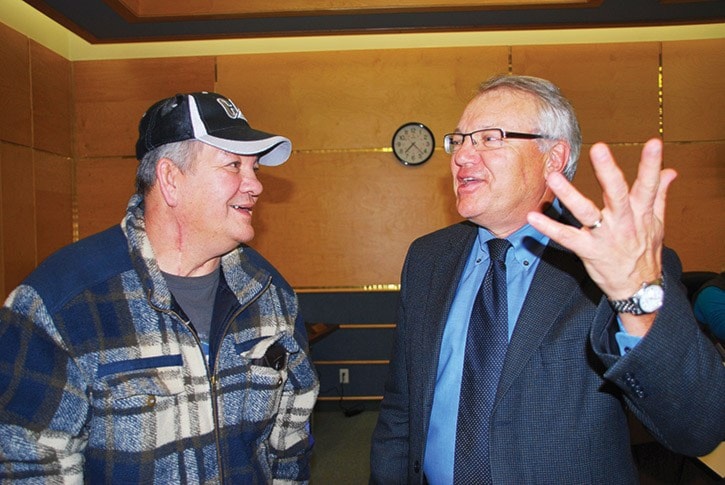Residents can expect the next step to be taken for the Cariboo Memorial Hospital master plan within the next six months.
At a CRD public meeting held Thursday in Williams Lake, Interior Health’s president and chief executive officer Dr. Robert Halpenny said that next step is to do a functional and indicative design.
The plan includes clinical expansion, a new parking lot, an additional 32 to 34 beds, a heli-pad on top of a roof, and changing where the ambulance arrives.
“The next step is to go through a process where we’ll really get down to where we’ll put things,” he said.
Rarely do communities build new hospitals, Halpenny added.
Typically they are built onto an older building, and that increases complications around wiring, asbestos, and sewage.
“We have to figure out if we’re going to add on, how much is it going to cost to do that,” Halpenny explained.
Once there’s a conceptual plan, it will be submitted to the Ministry of Health, followed up by a business case, outlining costs to build and costs to run the facility.
Interior Health will be returning to the Cariboo Chilcotin Regional Hospital District requesting funds to do the functional planning, he said.
CCRHD chair John Massier said the confirmation the plan will move to the next stage is good news.
“That will really show people of this community that you really do see the hospital moving forward,” Massier said.
Presently 64 per cent of people who arrive at the hospital in Williams Lake stay there. Another 18 per cent transfer to Royal Inland in Kamloops.
“By far the majority stay within the authority, and others will transfer to Vancouver or Prince George,” Halpenny said.
He described IH as a “rural” health authority.
“We’re different than the north in that the north has smaller numbers of communities that are further dispersed. We’ve got communities that are 250 people and are within 40 or 50 miles.”
The priority is to make sure patients in dire circumstances can get to the right place at the right time.
“The next step is to work with communities for the provision of primary care. The provision is going to change dramatically in the next 20 years. We have this pitch in the field that we need to have a doctor for everything.” He said he doesn’t think that’s going to happen. Rather, people will rely on the Internet and connections with professionals in other locations and the advent of nurse practitioners and physician’s assistants.
Massier shared concerns he has received by letter, including from residents in the Chilcotin because there is only one doctor stationed there and he is approaching retirement.
Halpenny said the vacant position will go on the list for physician recruitment and is a priority. “We make our priority for physician recruitment for areas that end up having three or less physicians. In a community like that it becomes a priority. We also have no intention of changing the nurse practitioner stationed in the Chilcotin either.”
Under the new First Nations Health Authority, the federal government has given the money for health to the First Nations.
“It’s not a bad thing. The First Nations Health Authority does have a really interesting and terrific vision for health care for First Nations. It is a primary care model, just as we’re trying to develop in our health care, but it also has culturally sensitive and holistic components which we all could pay some attention to,” Halpenny responded in concerns raised about how those changes will impact the way health care will be delivered.
Massier asked if that health care will be open to all Cariboo Chilcotin residents — First Nations and non-First Nations, however, Halpenny said that is something that will have to be discussed.
The money that came from the federal government is specifically for First Nations on reserve, he explained.
Halpenny showed a slide indicating that provincial funding increases to health authorities are declining.
In 2010/11 the increase was $79 million, in 2011/12 it was $76 million, in 2012/13 it was $78 million, in 2013/14 it will be $53 million and in 2014/15 it will be $27 million.
“With an increase in the population of elders, wouldn’t it be logical to keep increasing?” Bernard Littlejohn asked.
Responding IH board chair Norm Embree said health authorities have had to adjust by doing more with less or more with the same.
“Technology has played a huge role in helping with that, but that’s not to minimize that we will be under a huge amount of pressure.”
Greg Ashley urged IH to encourage more student physiotherapists to come to Williams Lake.
Ollie Martens asked why IH is spending 50 per cent less on capital funding in the region, compared to the capital spending of Northern Health in the region in the last decade.
Halpenny said IH disagrees with those figures.
“We went back and compared the two specifically Quesnel and Williams Lake, the major difference was in this area we didn’t put the money in to build a residential care facility, we went to a private partner. The private partner built it so we didn’t have to spend the money.”
Martens asked why Williams Lake cannot have more public-funded extended care spaces than exist now. “We have a lot of people that are staying home who do not have the proper care,” Martens said. “Not everyone can afford the private place. I think the citizens in this town deserve better.”
Home support numbers have been increased “dramatically” to try and keep people at home because there are statistics that show if people remain at home they live longer and there’s less risk of things like infections,” Halpenny replied.
